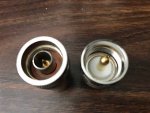Hello.
I'm getting a Diamond 70cm antenna that comes with either N or UHF female connector. I'll be using about 80' Andrew Heliax 1/2" coax. Would PL-259 connector work better than N on the 1/2" hardline? Would you go with N or UHF connector option?
Is there a retailer that would not only sell me the cable but also install the connectors for me on the hardline?
I'm just wondering, is there a difference between N and DIN connector?
I'd appreciate your feedback.
I'm getting a Diamond 70cm antenna that comes with either N or UHF female connector. I'll be using about 80' Andrew Heliax 1/2" coax. Would PL-259 connector work better than N on the 1/2" hardline? Would you go with N or UHF connector option?
Is there a retailer that would not only sell me the cable but also install the connectors for me on the hardline?
I'm just wondering, is there a difference between N and DIN connector?
I'd appreciate your feedback.


